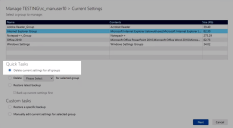Current Settings for Single Users
In this section:
- Delete All Profiles for a User
- Delete All Current Settings for a Group for a User
- Delete File or Folder Settings for a User
- Delete or Edit Registry Settings for a User
Delete All Profiles for a User
A quick task is available to delete all profile data for a single user (available in Personalization Operations 2021.1 and later). This action removes current settings, registry items, or file and folder items for all groups the user belongs to.
-
Search for and select a user.
The Manage User's Current Settings and Manage User's Backups buttons are now active.
- Click Manage
User's Current Settings.
The Current Settings dialog lists the names and content of the user's Application and Windows Settings groups.
- Under Quick Tasks, select the Delete current settings for all groups option.
-
Click Next.
The dialog displays a summary of the action(s) you have selected.
-
Click Execute Task.
The task is executed and a success message displays.
This action does not delete backup data for the user (or Legacy Session Data / Legacy Certificates).
Delete Current Settings for a Group for a User
To delete selected current settings, registry items, or file and folder items for a group for a single user:
-
Search for and select a user.
The Manage User's Current Settings and Manage User's Backups buttons are now active.
- Click Manage
User's Current Settings.
The Current Settings dialog lists the names and content of the user's Application and Windows Settings groups.
- Select the group for which you want to delete settings.
- Under Quick Tasks,
select the Delete option, and
then select one of the following options in the select box:
- all live settings
- all registry items
- all file/folder items
- If you are deleting
Windows Settings groups, select the appropriate Windows Settings option(s)
in a second select box, for example:
- all windows settings groups
- Taskbar and Start Menu
- IE10+ Cookies and History
Windows Desktop
You can select multiple Windows Settings Groups.
-
Click Next.
The dialog displays a summary of the actions you have selected.
-
Click Execute Task.
The task is executed and a success message displays.
Delete File or Folder Settings for a User
Add a delete action to a custom task to remove files or folder settings for a Windows Settings or Application Group. You can combine multiple file, folder, and registry actions in a single custom task.
- Search for and select a user.:
- The Manage User's Current Settings and Manage User's Backups buttons are now active.
-
Click Manage User's current settings.
The current settings dialog lists the names and content of the user's Application and Windows Settings groups.
- Select a group, and then under Custom Tasks select Manually edit current settings for selected group.
-
Click Next.
The dialog displays three tabs in which you can specify file, folder, and registry actions.
-
In the Files tab, select one or more files to delete.
Use the filter box to locate files and folders more quickly.
- Select Delete selected files.
-
Click Add action to task.
The Delete action is added to the Actions in Task list.
If you want to remove an action from the list, select its checkbox in the list and click the Delete icon (the trash can).
- To delete files:
- To delete folders:
- Click the Folders tab.
- Select one or more folders.
- Select Delete selected folder.
Click Add action to task.
The Delete action is added to the Actions in Task list.
-
To add custom actions for another Application or Windows Settings group, click Manage Another Group.
You return to the current settings dialog, where you can select another group.
-
When you have added all the required actions, click Execute Task.
The dialog displays a summary of the actions you selected.
-
Click Finish.
The task is completed and a success message displays
Delete or Edit Registry Settings for a User
Add a registry action to a custom task to delete or edit registry keys and values for a Windows Settings or Application Group. You can combine multiple file, folder, and registry actions in a single custom task.
-
Search for and select a user.
The Manage User's current settings and Manage User's Archives buttons are now active.
-
Click Manage User's current settings.
The current settings dialog lists the names and content of the user's Application and Windows Settings groups.
- Select a group, and then under Custom Tasks select Manually edit current settings for selected group.
-
Click Next.
The dialog displays three tabs in which you can specify file, folder, and registry actions.
- To change registry
settings:
- Click the Registry tab.
In the tab, use the registry browser to navigate to and select required registry key.
The table below the navigation tree is populated with value, type, and data information for the key. To edit a value, select it in the table first.
- Select
one of the following Available Actions:
- Delete selected key.
- Edit data for selected value.
- Delete selected value.
Click Add action to task.
The registry action is added to the Actions in Task list
-
To add custom actions for another Application or Windows Settings group, click Manage Another Group.
You return to the Live Settings dialog, where you can select another group.
-
When you have added all the required actions, click Execute Task.
The next dialog displays a summary of the actions you selected.
-
Click Finish.
The task is completed and a success message displays.

